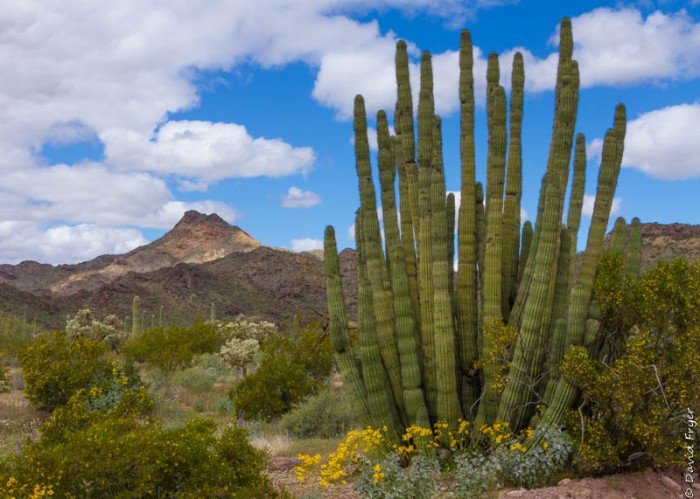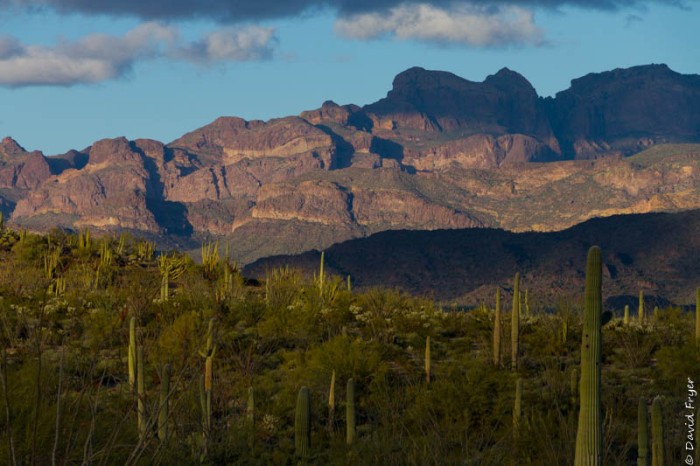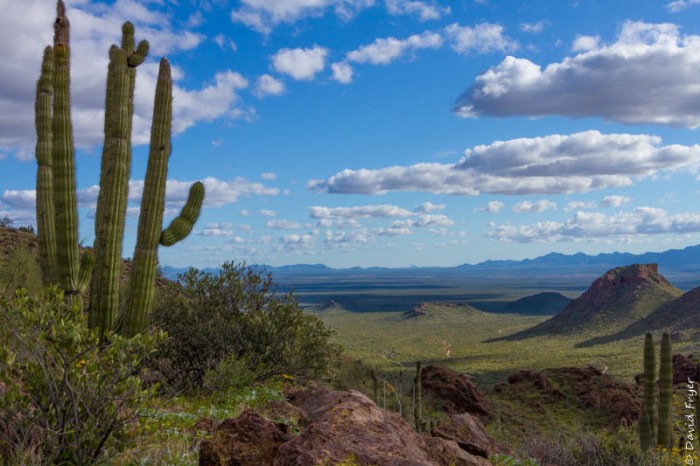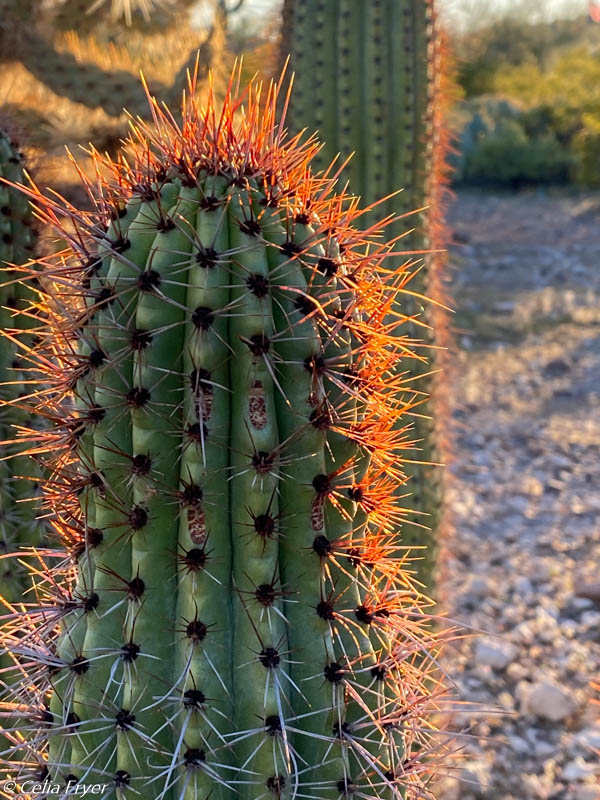The novel corona virus has been on everyone’s mind lately. Even though we are full timing, we, like you, are not immune to its impacts. Every day more and more state parks are closing and the national parks are suspending their ranger-led activities and shuttering the Visitor Centers. We too are practicing “social distancing” and washing our hands often. Being RVers during this crisis does have several positives. For one, we can decide, within limits, where we want to park our rig and how long we want to stay in a given location. Another advantage is that we can decide how far we want to be from virus “hot spots” and large metropolitan areas. For now we have decided to remain in the desert southwest in relatively isolated areas for the time being. We will continue to monitor the situation and make decisions accordingly. In the meantime we plan on enjoying the beauty of this country, great outdoors, and the warm weather.

David and I are at Organ Pipe Cactus National Monument in southern Arizona. The park is located right on the border with Mexico. To the east of the national monument is the Tohano O’odham Nation Reservation and to the northeast is the Cabeza Prieta National Wildlife Refuge. It is a very remote area of the state and there is only one road to and from the national monument. The nearest grocery store is in the town of Ajo, AZ about 40 miles north of the park. Some might say that we are really taking the “social distancing” mandate to an extreme but that is not the reason we are here. This unique place has been on our wish list of places to see for quite some time.
The best time to come to Organ Pipe Cactus NM is generally in the spring before the weather gets too hot. In the past we have missed the weather window and had to put off coming here. We were not sure if the weather would cooperate this time either but currently the temperatures are still very pleasant with highs generally in the upper 60’s and lower 70’s. As it turned out for us, it has been the perfect time to visit this unique part of the Sonoran desert.
The Sonoran Desert extends from southwest Arizona into southern California in the United States and then 500 miles south along the Gulf of California in Mexico. There are different subregions of the desert and this one is often called the “Green Desert” because of the amount of rain that they receive here. There are two rainy seasons here: the monsoon rain season with its heavy rains and flash floods during the summer months and the soaking rains during the winter months. Due to the plentiful winter rains, the desert is greener than others and, in the spring, it is replete with 40 different species of wildflowers. The wildflower bloom is a joy to behold. Everywhere we look now there are many, many flowers in bloom. There are blue lupines, desert marigolds, gold poppies, California poppies, and many others. The cacti and ocotillo flowers are also adding color to the landscape. On our drive to and through the park, we saw an array of gorgeous wildflowers, cacti, and mountains and we knew we were in for a special treat.

When we arrived at Organ Pipe Cactus NM, we made our way to Twin Peaks Campground. It is dry camping only, i.e. no “hook ups,” but there is a place to fill up your fresh water tanks and there is a dump station as well. Also there are solar-heated showers in the bathhouses. Each site has a concrete pad with a picnic table and grill and a few have ramadas to shield you from the hot sun. Some campsites allow generators and there is a no generators section. There is a tent only section as well. What really impressed us about the campground was that it looked like it had been landscaped. Each site is nestled among the cacti and the flowering scrub brushes and wildflowers. There are camp hosts that come by and clean each site regularly. This is the nicest national park campground that we have seen.
The Organ Pipe Cactus NM opened in 1937 and was named for the unique cactus that is found here. Early European settlers called this cactus “organ pipe” because the dried stems of the plant reminded them of the pipes of a church organ. The Organ Pipe cactus plants grow mainly in Mexico and Baja California. In the U.S., it is rare to see them except for in Organ Pipe Cactus NM in Arizona. This is the only place in the U.S. where the Organ Pipe Cactus grows wild. For that reason, in 1977, this area became a UNESCO biosphere reserve.

The Organ Pipe Cactus is a tropical plant and it grows to an average height of 15 feet and has a number of stems that are about 6 inches thick. Unlike the Saguaro cactus, all of the stems grow from the base of the plant. The Organ Pipe Cactus may live 150 years and it does not produce flowers until it is 35 years old. It also produces tennis ball sized fruit during the summer months. The cactus prefers rocky soil on hillsides below 3,000 feet because it is sensitive to the frost. The cold weather causes indentations in the stems of the plant. Interestingly, bats usually pollinate the plants. On several of our hikes, David and I saw some abandoned mines that are now protected habitats for bats. The bats roost and rear their young in the mines during the summer. In the fall and spring, bats often stop here during their migrations. So far we have not seen any bats during our stay here but they are critical to the survival of the Organ Pipe Cactus.

Organ Pipe Cactus NM offers many activities that you can enjoy during your stay here. Among them are scenic drives that offer fantastic views of the Saguaro, Senita, and Organ Pipe cactus plants as well as the Ajo, Santa Rosa, Puerto Blanco, and Sonoyta Mountains. Birding is also a favorite here as there are over 270 species of birds that visit the park throughout the year. We have seen Gambel’s quail, Costa’s hummingbirds, Harris’ hawks, and many others on our hikes. For those, like us, who like to hike, there are trails in many parts of the National Monument. All of the trails afford you some impressive vistas and lovely landscapes. We actually could see Mexico from one of the trails. (We will have more on specific hikes and activities in the park in another post coming soon.)
The Park offers free hiker shuttles and van tours led by the park rangers. Unfortunately, for now, these programs have been canceled and the Visitor Center has closed until further notice. Even so, the rangers are still around the park and have been very friendly and helpful. They have set up a table in front of the Visitor Center with information and they have been out there answering questions and giving guidance. All of the interactions that we have had with the rangers and staff here have been very positive.

David and I have visited four deserts during our more that 2.5 years on the road: the Chihuahuan (Carlsbad Caverns, City of Rocks, White Sands NP), the Great Basin (Antelope Island), the Mojave (Joshua Tree NP, Death Valley, Anza Borrego SP, Lake Havasu), and the Sonoran (Kofa NWR, Salton Sea, Yuma, El Centro). We are enjoying our time here in the Sonoran Desert and are excited to explore the beautiful Organ Pipe Cactus National Monument.















Thanks for the beautiful photos and description of an area I’ve never visited. It looks like a great place to be social distancing. I’m glad to hear they have kept the campground open.
LikeLike
Thanks. This is a wonderful place and off the beaten path. We had several folks recommend coming here and we are glad we did. We are glad the campground is open even though all the facilities like visitor center, kiosks, etc. are closed. We have a “plan B” and “plan C” in case they do close, but the fact that the national parks have now been declared free makes me hope that they will remain open.
LikeLiked by 1 person